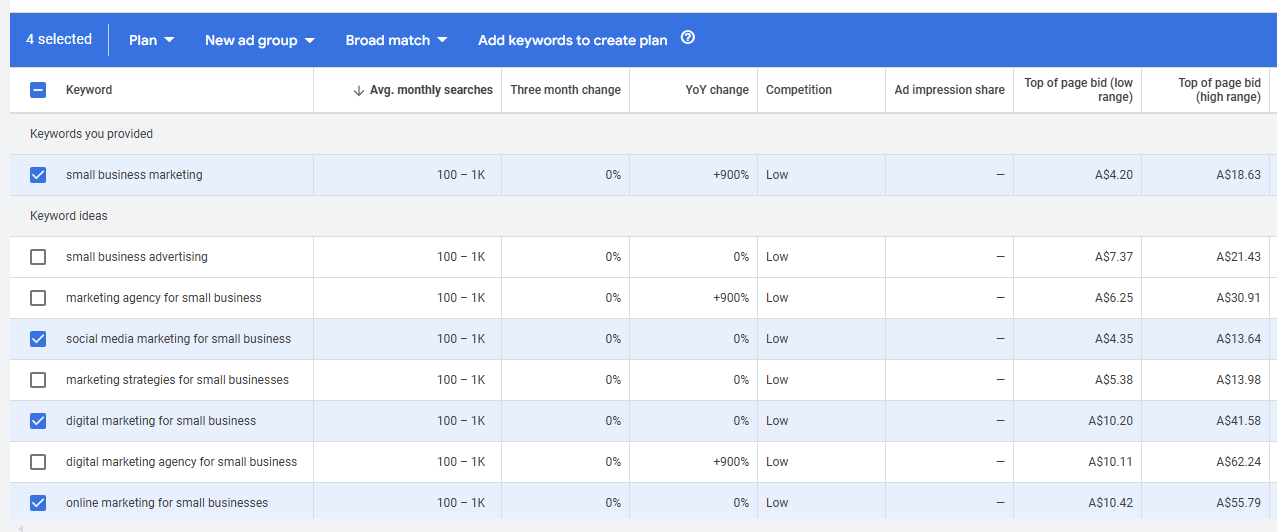Google Keyword planner: How to Create Blogs for Your Small Business
(Without Spending 5 Hours Writing Them)
If you’ve ever poured hours into writing a blog post — only to wonder if anyone out there actually cares — you’re not alone. The truth is, great ideas aren’t enough.
To create content that resonates and brings real traffic to your website, you need to know what your potential customers are actively searching for — not just what you think sounds good. That’s where Google Keyword Planner comes in.
It’s a free, practical tool we recommend to small business owners who want to get smarter (not busier) with their marketing. Here’s how to use it to validate your blog ideas, pick the right topics, and stop guessing what your audience actually wants to read.
Why Use Google Keyword Planner?
Most small business owners want their blog to do two things:
Provide real value to their customers.
Help bring in more traffic from search engines.
Google Keyword Planner helps you achieve both by giving you a clear window into:
How many people are searching for a topic
How competitive the topic is
Whether interest is growing (or dying off)
In short: it’s how you stop writing blogs that sound nice but go nowhere — and start creating posts that actually get found.
What to Look For in Google Keyword Planner 🔎
When you're first using the tool, focus on these four simple but powerful metrics:
1. Average Monthly Searches
What it tells you: How often people search for that keyword each month.
What to look for:
✅ Keywords with 10–1,000 searches are perfect for small business marketing.
✅ Big enough to drive traffic, small enough that you're not fighting against massive companies with big ad budgets.
⚠️ Avoid keywords with huge volumes (10,000+), unless you love banging your head against SEO walls.
2. Three-Month Change
What it tells you: Whether interest in the keyword is rising or falling in the last 90 days.
What to look for:
✅ Positive growth = trending topic = jump on it.
⚠️ Negative growth? Maybe don't invest your next Sunday afternoon writing about it.
3. Year-Over-Year (YoY) Change
What it tells you: How interest compares to the same time last year.
What to look for:
✅ Steady or growing YoY trends are your friends.
⚠️ Big YoY drops might mean the topic is going stale.
4. Competition
What it tells you: Roughly how hard it will be to rank for that keyword (based on how many people are bidding for it in ads).
What to look for:
✅ Low or medium competition = ideal.
⚠️ High competition = you'll need either a big budget or a seriously unique take.
🛠️ How to Use These Insights to Write Smarter Blogs
1. Start With a Keyword, Not Just an Idea
Find a keyword that fits your criteria first — then build your blog around it.
Example: If "marketing strategies for small business" shows good volume and low competition, write a blog that directly speaks to that need.
2. Use Your Keyword Naturally
No weird stuffing. Just weave your keyword into:
Your blog title
A few subheadings
The introduction and conclusion
Your meta description & URL slug (i.e. your business.com.au/blog/your-special-keyword-topic
Keep it sounding human — that’s what both readers and Google love.
3. Optimise for Related Keywords
Google Keyword Planner also shows you related search terms. Sprinkle a few variations through your blog to capture extra traffic without extra effort.
4. Validate Ideas Before You Write
Before you invest hours writing, ask:
Is anyone actually searching for this topic?
Can I tweak the angle to match a keyword people are using?
Example: Instead of "Why Consistency is Key in Marketing" (zero searches), shift to "consistent marketing strategies" (proven search traffic).
🧠 Pro Tip: Go for Long-Tail Keywords
Long-tail keywords = specific phrases like "small business marketing tips" instead of just "marketing". They’re less competitive, easier to rank for, and attract people who are more ready to engage. They’re marketing gold for regional and rural small businesses.
🏋️♀️ Final Thoughts
Writing blogs that actually get found (and actually help your business grow) isn’t about being a marketing wizard. It’s about understanding what your customers are already looking for — and showing up where they are.
Google Keyword Planner makes it easier to stop guessing, start validating, and create smarter marketing content that works for you over time.
If you’re feeling time-poor (and let’s be honest, who isn’t?), combining smart keyword research with tools like ChatGPT can also be a game-changer.
Stay tuned — we'll show you exactly how to blend AI into your blogging workflow without losing your brand voice or your sanity.
👉 Check Out More Tools of the Trade — practical platforms we actually use to make small business marketing simpler and stronger.

